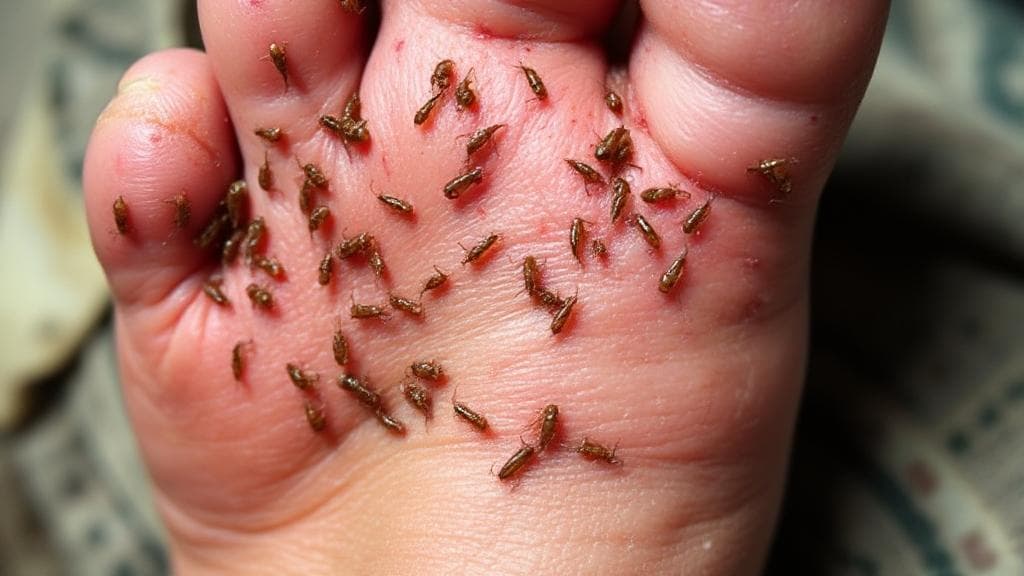What Are Jiggers?
Jiggers, scientifically known as Tunga penetrans, are the smallest known parasitic fleas, measuring only about 1mm in length. They are primarily found in tropical and subtropical regions, particularly in sub-Saharan Africa, South America, and the Caribbean. Female jiggers burrow into the skin of warm-blooded hosts, typically affecting the feet and toes, though they can penetrate any part of the body. Once embedded, they begin feeding on the host's blood and dramatically increase in size while producing eggs.
Causes and Risk Factors
Several factors contribute to jigger infestations:
- Walking Barefoot: This increases the risk of jiggers penetrating the skin
- Poor Housing Conditions: Especially those with dirt floors
- Poor Hygiene: Lack of proper sanitation and hygiene
- Living Conditions: Overcrowded and unsanitary environments
- Proximity to Infested Animals: Animals can harbor jiggers, leading to human infestations
- Limited Access: Poor access to healthcare resources
- Poverty: Economic factors that limit prevention and treatment options
Symptoms and Stages
Initial Stage
- Itching and irritation at the entry point
- Small black dot visible on the skin
- Mild discomfort when walking
Advanced Stage
- Severe pain and inflammation
- White, pea-sized lesion with a black dot in the center
- Difficulty walking
- Secondary bacterial infections
- Nail deformation
- Tissue damage
Complications
If left untreated, jigger infestations can lead to serious complications:
- Tetanus infection
- Gangrene
- Loss of toenails
- Difficulty walking
- Social stigma and isolation
- Deformities, particularly in the feet
Diagnosis
Diagnosing a jigger infestation typically involves a physical examination of the affected area. Healthcare providers look for the characteristic signs of jigger penetration, such as a small black dot surrounded by a white halo. In some cases, a magnifying glass may be used to confirm the presence of the flea.
Treatment Options
Medical Intervention
-
Sterile Removal
- Careful removal of the entire flea using sterile instruments
- Crucial to remove the complete flea to prevent complications
-
Wound Care
- Cleaning and disinfection
- Antiseptic application (hydrogen peroxide, iodine)
- Tetanus vaccination if necessary
-
Infection Management
- Antibiotic treatment for secondary infections
- Can be topical or oral, depending on severity
Post-Treatment Care
- Keep the affected area clean and dry
- Apply antiseptic solutions
- Monitor for signs of infection
- Complete prescribed medication courses
- Regular follow-up with healthcare providers
Prevention Strategies
Prevention is always better than cure. - World Health Organization
Effective prevention methods include:
- Wearing closed shoes regularly
- Keeping floors clean and dry
- Regular inspection of feet
- Using insecticide sprays in affected areas
- Maintaining good personal hygiene
Community Response
| Strategy | Impact |
|---|---|
| Education | Increases awareness and prevention |
| Sanitation | Reduces transmission rates |
| Healthcare access | Improves treatment outcomes |
| Social support | Reduces stigma |
Long-term Solutions
Addressing jigger infestations requires a multi-faceted approach:
- Improving living conditions
- Enhancing access to healthcare
- Providing proper footwear
- Implementing community education programs
- Strengthening local healthcare systems
For more information, visit the World Health Organization's Neglected Tropical Diseases page or the Centers for Disease Control and Prevention.
